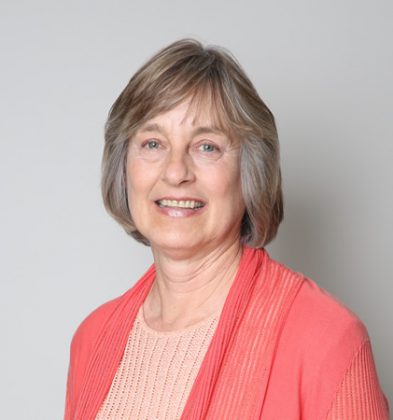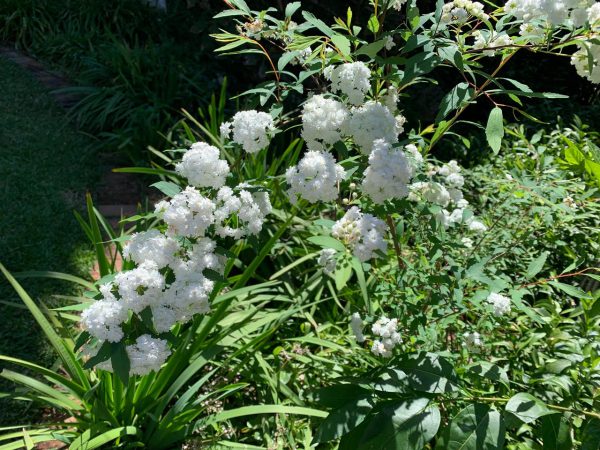The Plant That Showed Me Home

By Ann Christoph
I have sworn off watching the news. Viewing maps of the progress of the disease, seeing stretchers being wheeled into emergency rooms, and hearing about how long it will take to develop a vaccine are severely anxiety-producing. We are barraged with alarming facts about which we can do nothing. It has become more and more difficult to sleep. I’ve switched to reading books that have nothing to do with our present situation.
I am following instructions, staying at home, working alone, taking walks around the neighborhood, and having long-distance relationships with my friends. I don’t know what else I can do except try to write a column that you could read before going to bed, and fall comfortably asleep, your worries subdued by a distracting, calming story. So here goes.
It’s about the bridal wreath bush, Spirea. It’s not a common plant in California, but very popular in the mid-west where I grew up.

My grandfather, Ted Christoph, was the youngest son of Pauline and Franz Christoph who had emigrated from Germany in the 1870s. Their first plot of land was a swamp, but soon they were able to buy a farm on a gently rising hill close to the town of Chilton, Wisconsin. Most farms were 80 acres, as they were distributed by the government, but gradually my grandfather increased his holdings by acquiring two additional farms nearby. There was one farm in the middle of this domain of cows, pastures, wheat, oats and clover that he had an eye on. My dad, Paul, the only child of Ted and his wife Barbara, was growing up—“Wouldn’t it be just right if he married the daughter of the family who owned the coveted farm?” my grandfather thought.
But first, Paul had to become an educated farmer, and off he went to the University of Wisconsin. That’s where Paul met Marjorie, a home economics and journalism major from Chicago. Eventually he took her to meet his parents and announced their engagement. Not well received at first. How would this city girl perform as a farm wife? What was wrong with a local bride? We still have a letter that my dad wrote his parents after that first meeting, saying that he and Marge were certain of their feelings and making it clear there would be no wavering from their planned marriage.

A June wedding in Chicago was followed by settling in in a small apartment in Chilton, where they lived when I was born. Soon though, the farm in question came up for sale and Ted and Paul arranged the purchase. Father and son both got their ways! And my mother proved to be a farm wife extraordinaire, writing and publishing a magazine about the cattle our farm specialized in, Woman’s Club, Homemaker’s Club, and fundraising to build the much-needed hospital. From then on my memories are of that Victorian farmhouse with its flowing border of gently arching bridal wreath bushes. Their tiny white flowers lined along curving delicate branches are the backdrop of the happy summer birthday parties as we grew up. They still say home to me.
There were pressures that as a child I was not aware of. I didn’t learn until recently that all those years we had the farm that my dad hadn’t been able to pay anything but interest on the loan for the purchase. When I was 16 my dad decided to move the family to Arizona where he learned that the dairy business could be profitable.
I felt wrenched away from the home I loved, not only the house but the barns, the cows that I knew personally, chickens, garden, pony, and doting grandparents. Tragically, my grandfather died within two years of our exit. I was never so attached to the farm in Arizona—it became just a place I came to see my family between semesters at college.
I relished trips to Wisconsin to visit Grandma in summer and holiday breaks. Once when I was 19 she called me and asked, “would you ever come back here to run this farm?” Still wondering where my education was leading, I felt overwhelmed by the enormity of the question and declined. She sold it soon after and moved to live with her sister in town.
Happy memories and losses led me here to Laguna. First, after landscape architecture graduate school in 1971 I worked with Fred Lang. Starting at $4 an hour, after nine years my wage was $10! Still I was able to save for a down payment on a house. After our looking at some too ramshackle, or others too expensive, our Realtor took us to a log house on Wildwood Road. There in the backyard was a bridal wreath bush. It told me, “this can be your home now.” And it is.
It bloomed beautifully every spring. We boxed it up and moved it when we built a bathroom addition. Still it thrived. Then oak root fungus invaded our yard. Major trees and large shrubs died. The bridal wreath lived, but struggled and was more diminished every year. I wondered if it too would succumb.
Not this year. I was surprised to see courageous branches fully leafed out and a strong flush of white flowers marking my replacement home of more happy memories.
It’s a privilege to be home.
Christoph is a landscape architect and former mayor.





Thank’s Ann for the lovely story. We all found our way here and are blessed for having done so. No place I’d rather be holed up during this scare! I say we hold a celebration in your yard with this “everlasting Bridal Bush” when this virus situation is over. Best, MJ